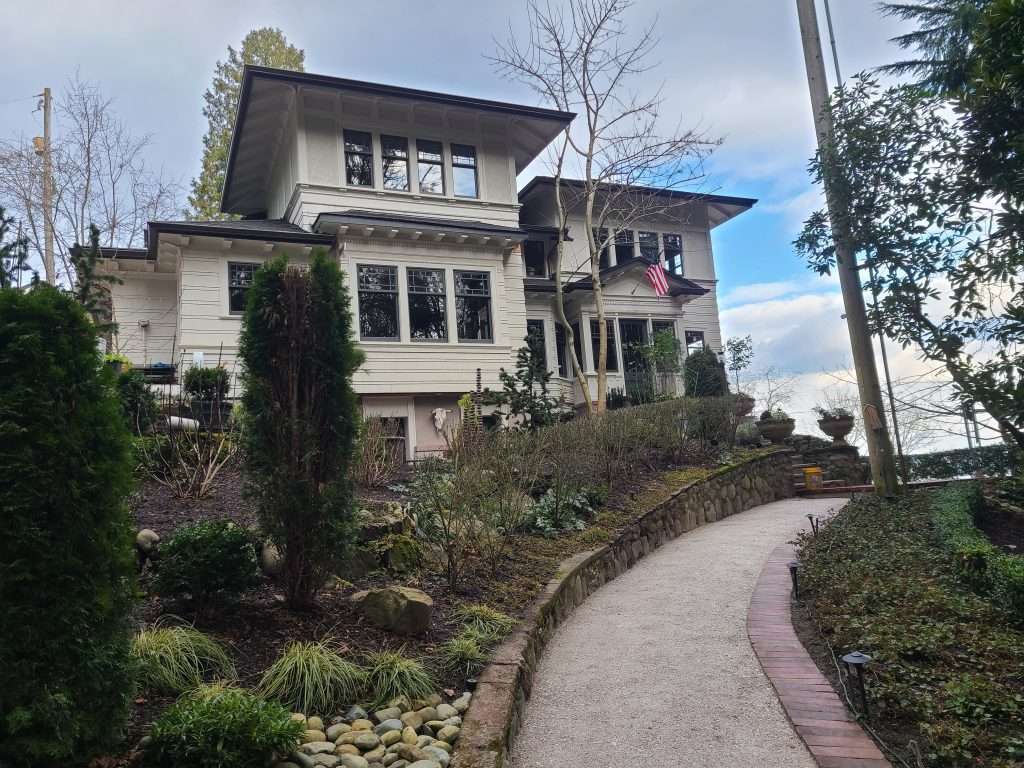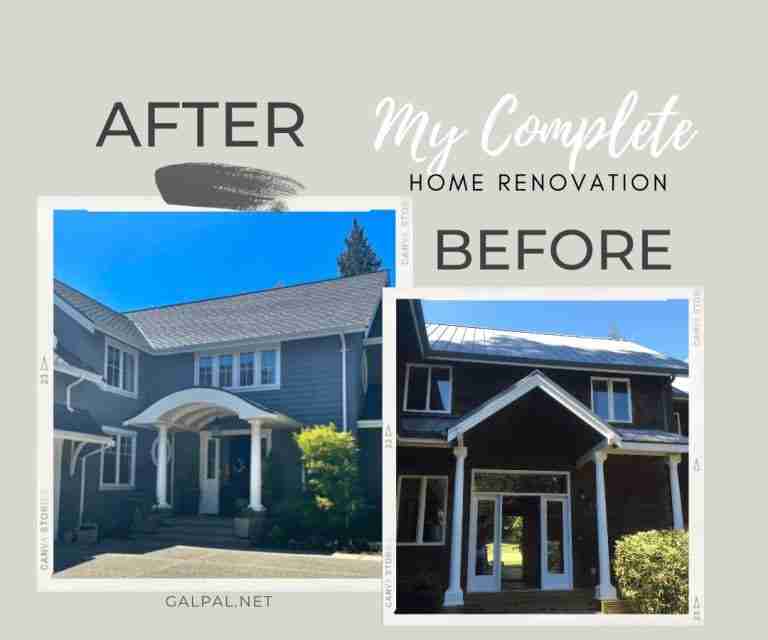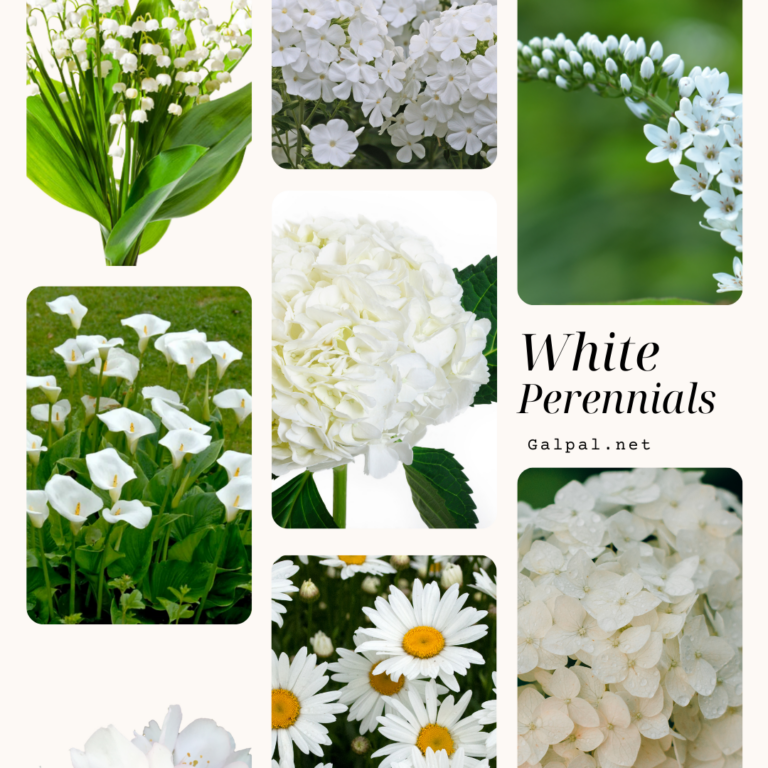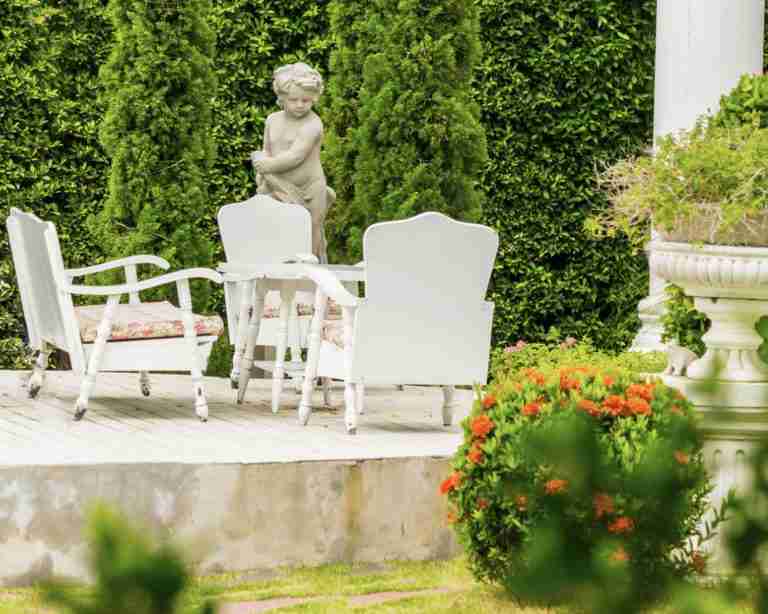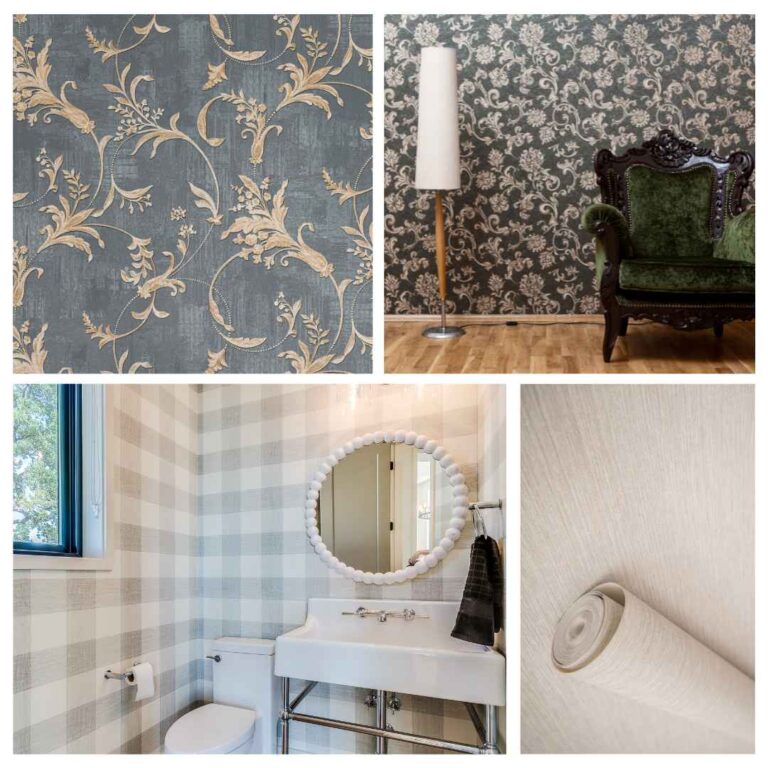Top 18 Beautiful Path Design Ideas and Walkway Pavers
Wandering along a thoughtfully designed pathway feels like strolling through a living storybook.
A well-designed pathway can add both value and appeal to your home, providing a functional and visually appealing route for visitors and homeowners alike.
With so many modern style pathway designs to explore, you have the opportunity to create a unique and personalized outdoor walkways that perfectly complement your home and landscape.
From sleek concrete slabs to winding brick walkways, and from pebbled mosaics to wooden chip paths, the possibilities are endless. In this post, we’ll take a closer look at some of the most popular and innovative pathway designs, offering inspiration and tips for creating a pathway that is both beautiful and functional.
What To Consider When Planning a Pathway
What is the purpose of your path? Always consider the natural surroundings, design style of your home, length of the path and square footage, budget and overall esthetics. There are many DIY paths that anyone can install themselves. Hiring a creative landscape designer is always a good idea as well.
Whether you’re looking to increase your home’s curb appeal or just add a touch of style to your outdoor living space, a well-designed pathway is a great place to start.
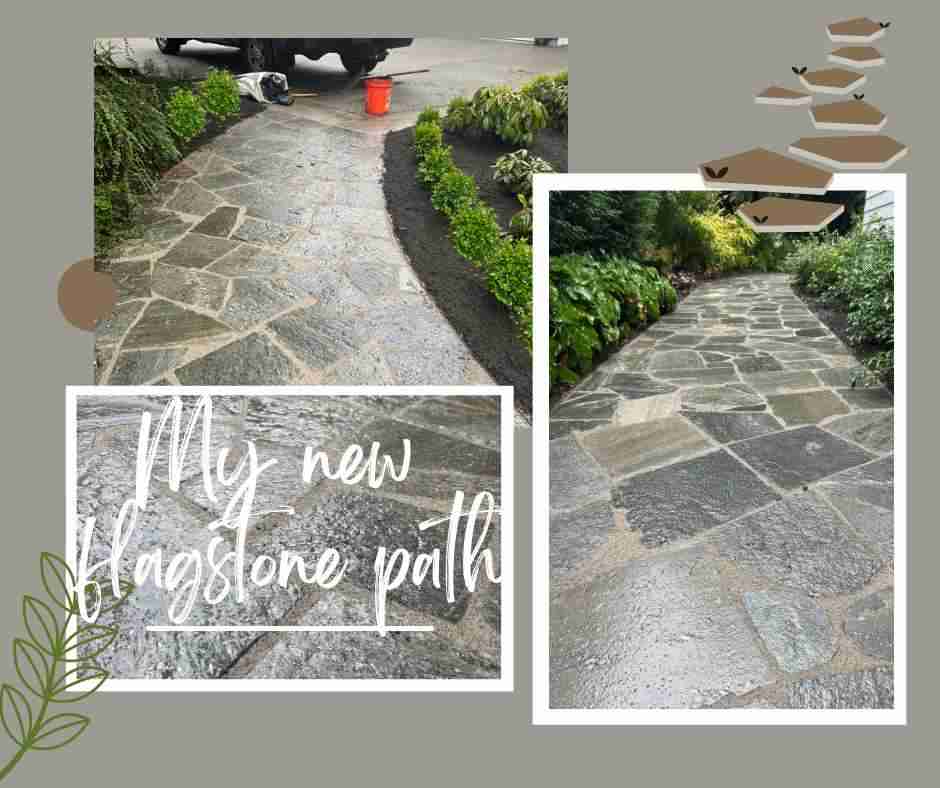
Top 18 Pathway Designs To Consider
1. Beautiful Flagstone Pathway Set With Sand
Flagstone paths create a rustic, natural look or a more formal, polished look depending on the type of flagstone and how it is set. You can lay your own path or hire an expert to do it. I love our flagstone path because the color of the stone matches the exterior of our patio wall.
Flagstone pathways are popular for a few reasons:
- They are durable: Flagstones are very durable and long-lasting, making them a good choice for high-traffic areas.
- They are versatile: Flagstones come in a variety of colors, textures, and sizes, which makes them versatile to a wide range of design styles.
- Slip-resistant: Flagstone pathways have a natural slip-resistant surface, making them a good choice for pathways that will be used in slippery conditions.
- Low maintenance: Flagstone pathways require minimal maintenance, unlike some other types of pathways that need to be sealed or painted.
Flagstone pathways are designed in a variety of patterns, such as a random pattern, a running bond pattern, or a herringbone pattern. It’s important to choose the right type of flagstone for the location and the climate. Some types of flagstone, like sandstone, are not suitable for areas with heavy freeze-thaw cycles.
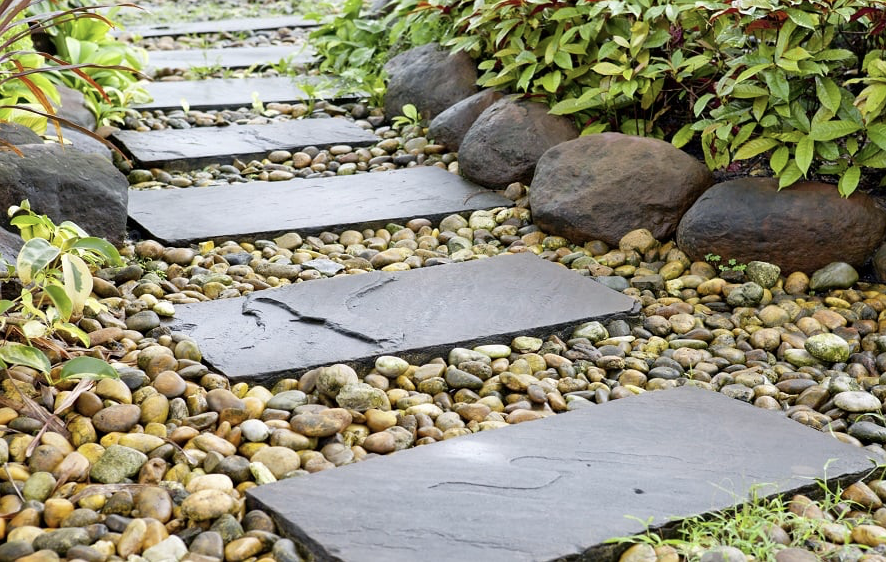
2. Flagstone Pavers Set With Rocks
A flagstone pathway set in rocks with rectangular or irregular-shaped pieces of flagstone (natural stone) into a bed of rocks is a popular style of garden path.
The rocks and other materials serve as a base for the flagstones, and help to keep them in place. This type of pathway is often used for a more natural, rustic look and can complement landscaping designs that feature natural stone and rocks.
The flagstones can be arranged in various patterns, and the space between them can be filled with smaller rocks or other materials to create an attractive, low-maintenance pathway.
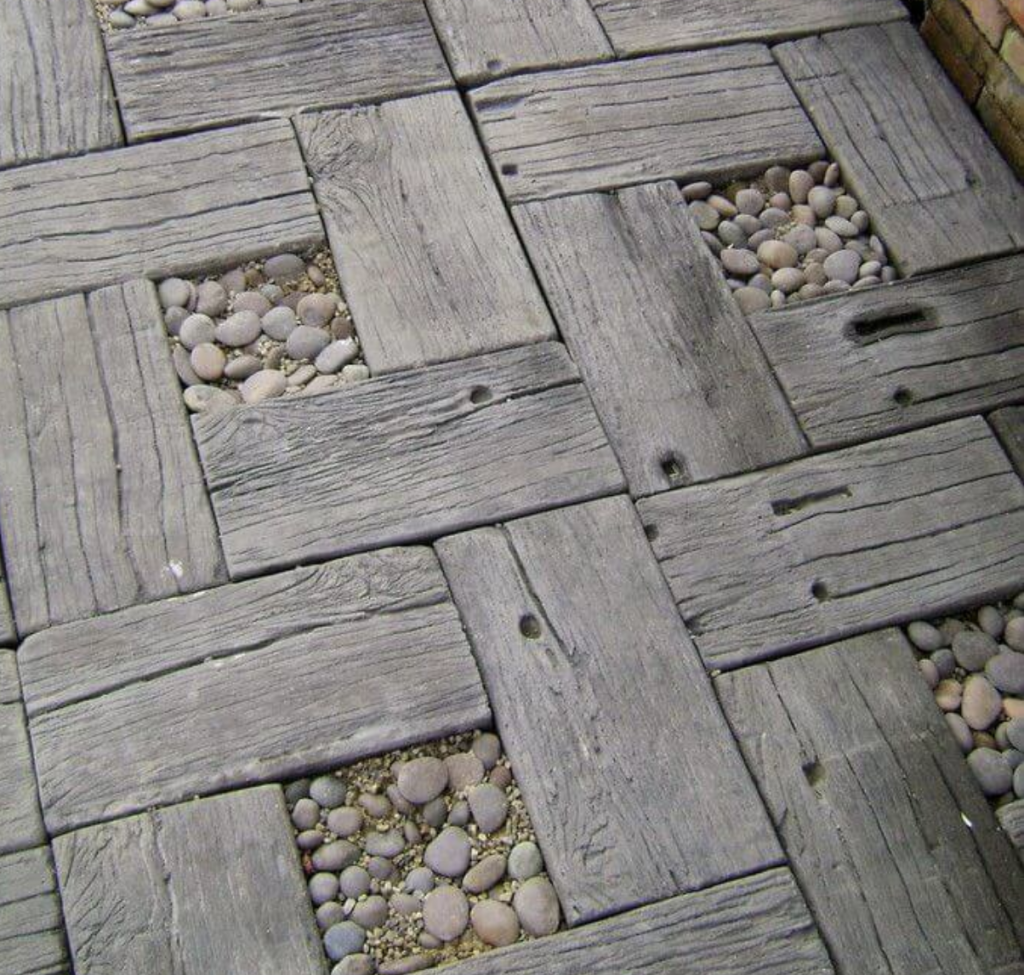
3. Romantic Parquet & Stone Pathway
A romantic aged wood parquet and stone pathway is a type of outdoor walkway that combines different materials to create an attractive, charming look.
The term “parquet” refers to a geometric pattern made of small, rectangular pieces of wood that are arranged in a repeating design. In this case, the wooden parquet is combined with stone to create a pathway.
The aged or weathered appearance of the wood and stone adds to the romantic, vintage look of the pathway. This type of pathway can be used in a variety of outdoor settings, such as gardens, parks, or outdoor living spaces, and can complement a variety of architectural and landscaping styles.
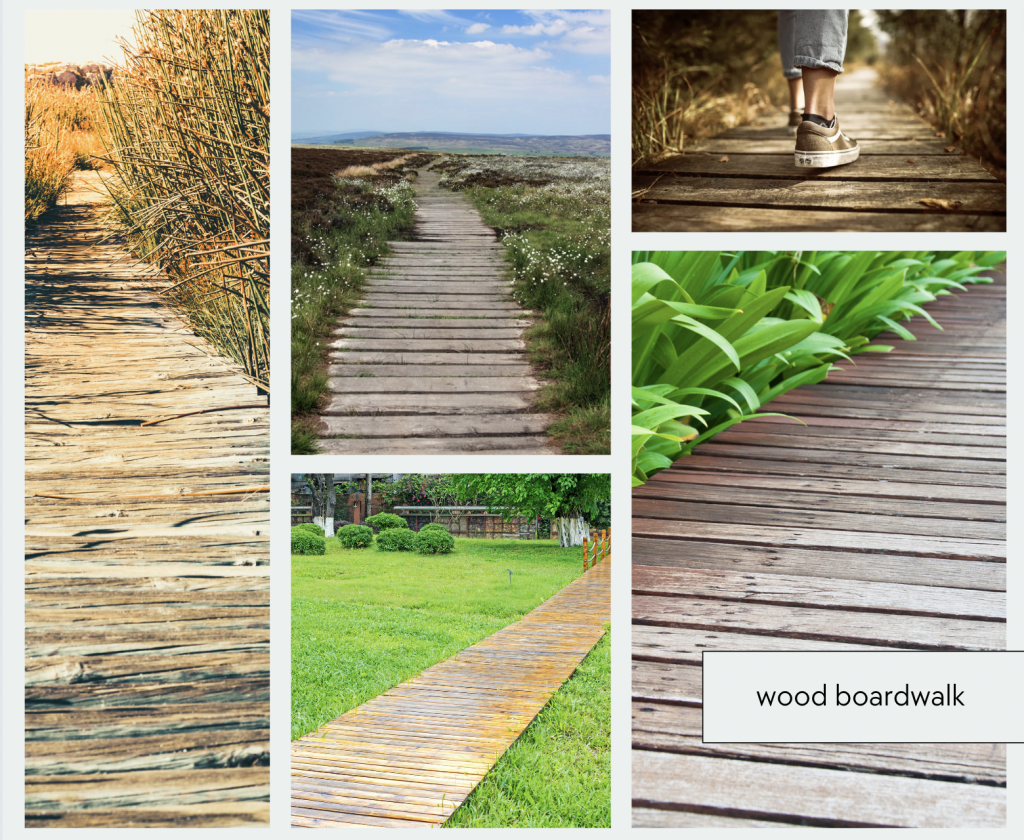
4. Wooden Boardwalk Design
An elevated wood walkway with wooden planks make for a unique style depending on the type of path you design.
Boardwalks are popular in many types of landscapes, including wetlands, marshes, and other areas where the ground may be soft or wet.
These paths provide an attractive way to walk through these areas without getting muddy or causing damage to the natural environment. Boardwalks can also be used to create raised pathways over lawns, gardens or other landscaping features.

5. Modern Concrete Slab Pavers Set In Small Rocks
When designing a modern pathway with modern concrete slabs, consider incorporating unique design elements to make it stand out, such as patterns, contrasting colors, or textures. Additionally, ensure that the pathway is properly spaced, leveled, and compacted to ensure stability and longevity. There is little maintenance required with thick concrete slabs.
Rectangular concrete pavers have been arranged in a slightly staggered fashion to create a curved pathway that runs through this contemporary backyard. Rectangle pavers set in small rocks adds texture and interest to the path.
If you love the modern look, you will appreciate the simple and clean design of concrete block pavers.
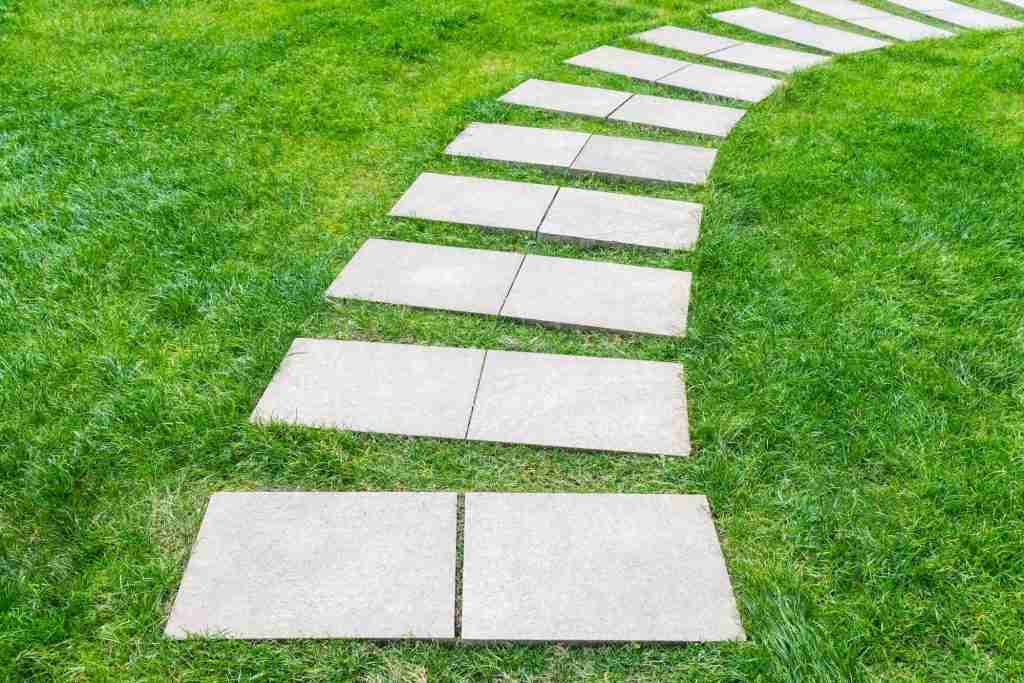
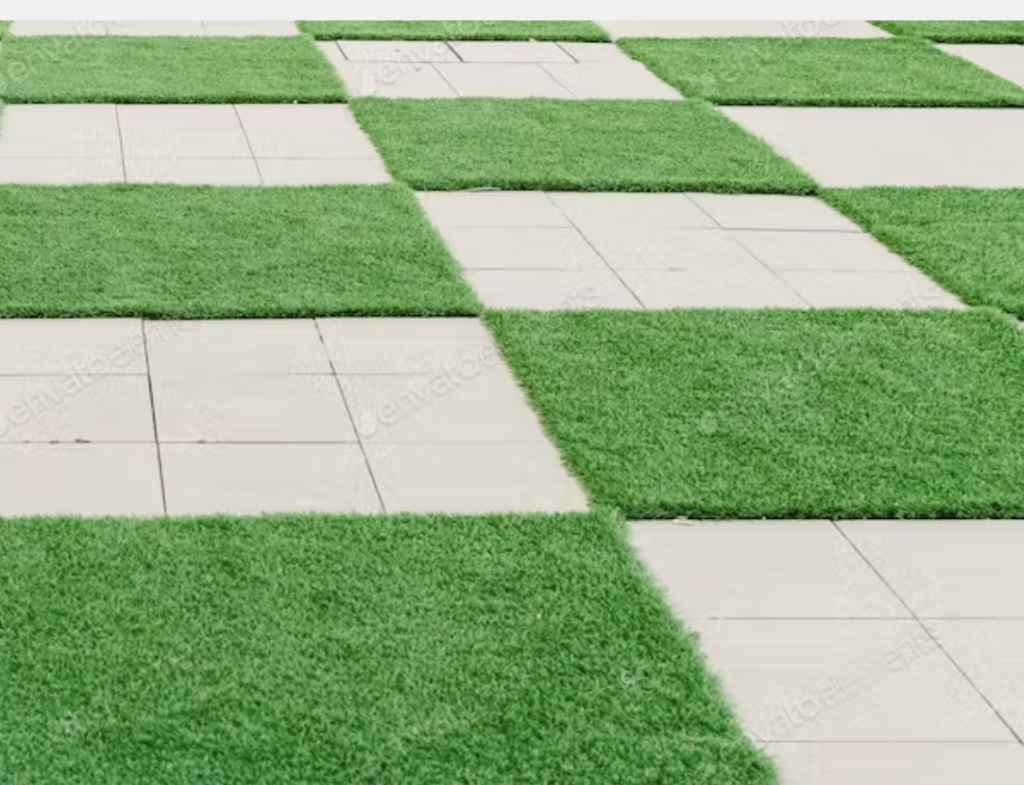
6. Stone Pavers Set In Grass
Stone pavers set in grass can create an appealing walkway design. By setting stone pavers in grass, the walkway becomes a part of the landscape, rather than an imposing structure. This creates a natural and harmonious connection between the walkway and the surrounding environment.
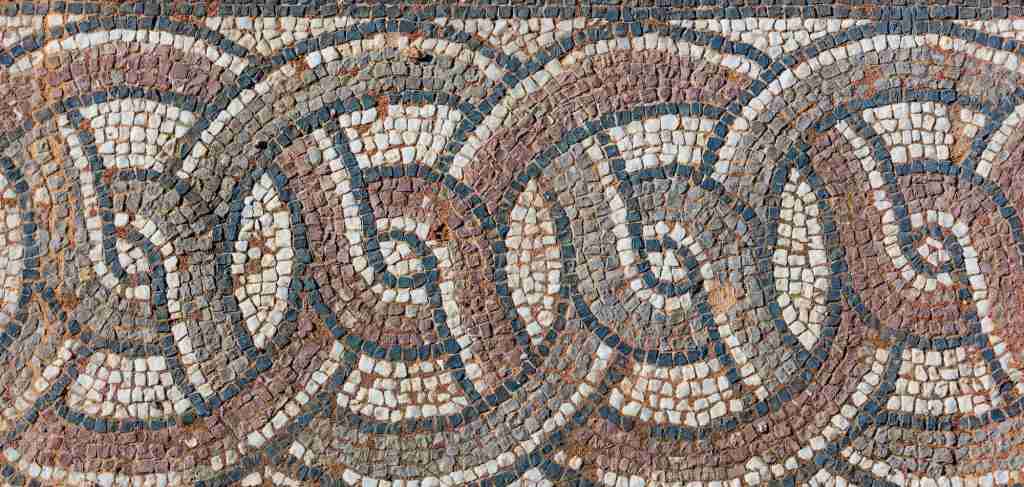
7. Mosaic Designed Pathway
A mosaic pattern is a way of laying a pathway where the stones are laid in a specific pattern, creating a decorative and intricate design. This method is often used for pathways that are intended to serve as a focal point in the landscape.
Natural stone tiles, such as slate or granite, can be used to create a rustic, earthy look. Of consider pebbles: small, smooth stones can be used to create organic, flowing designs.You can also find mosaic pebbles that are pre-formed mosaic pieces made of small stones or glass can be used to create precise designs.
When creating a mosaic pathway, the materials you choose will largely depend on the desired look and feel of the pathway. Consider factors such as durability, color options, and the amount of maintenance required when choosing materials for your mosaic pathway.
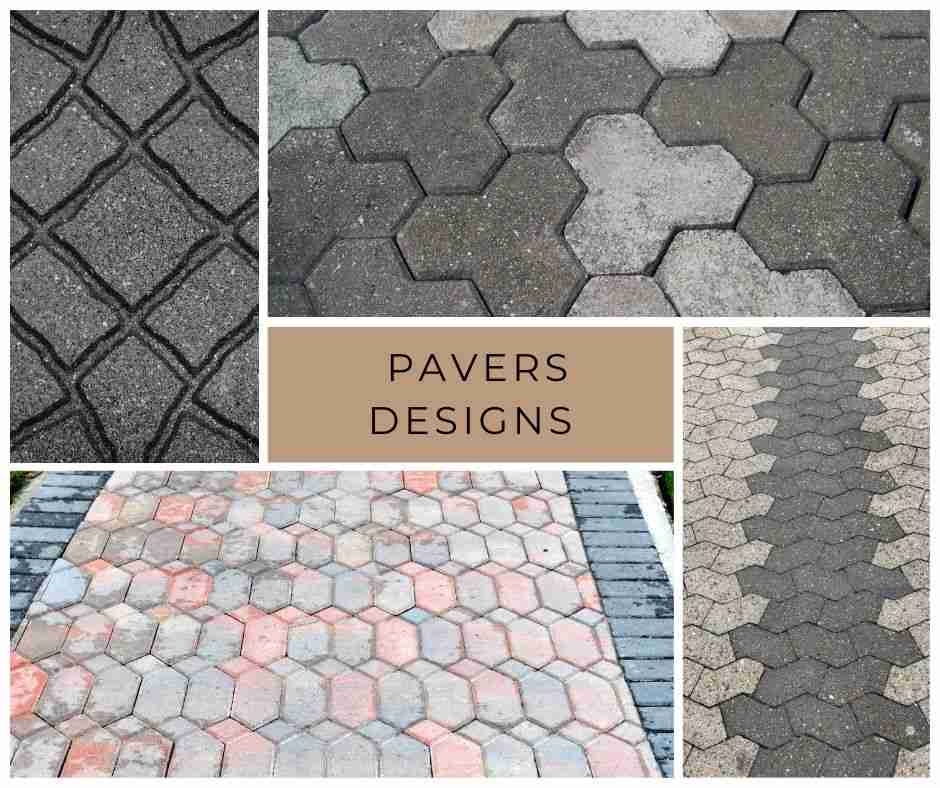
8. Concrete Paver Walkway Designs
You can create the look and feel of natural flagstone with the modern concrete pathways today. With an irregular shape and virtual joints, it creates a random look that flows harmoniously into the surrounding landscape.
Modern shaped pavers come in alluring colors, is sure to become a popular choice amongst homeowners looking to boost their curb appeal or up their backyard landscape.
Concrete blocks are available in various shapes and sizes. It is made of molded cement concrete, and it is easy to install as they have a shape that easily interlocks with the adjacent blocks.
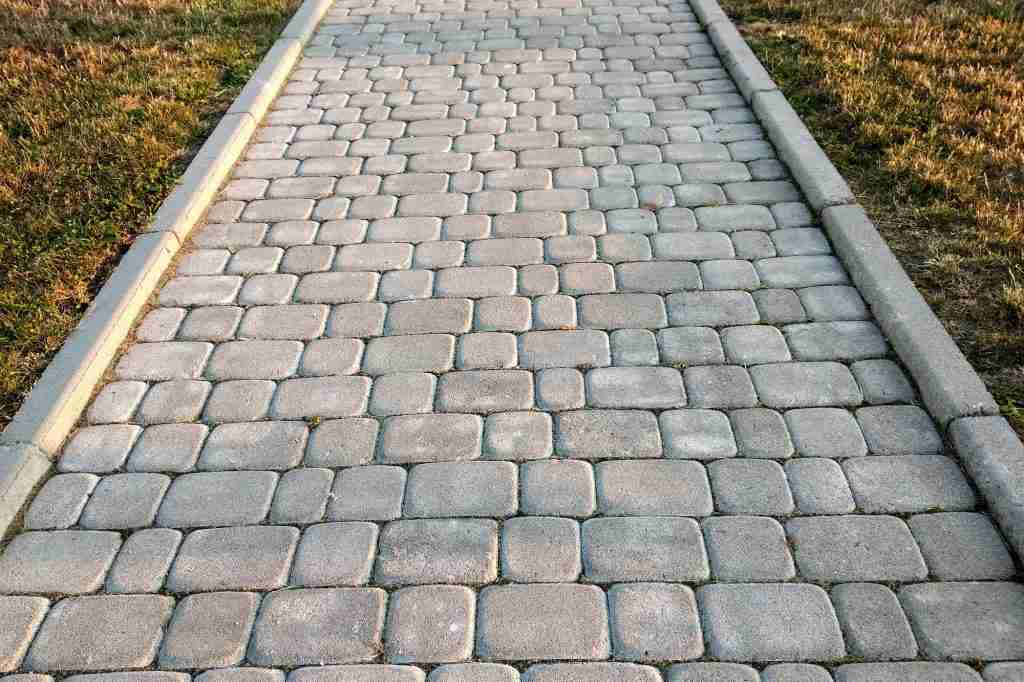
Due to its durability, the concrete paver is a prevalent flooring choice for driveways and roadways. It is cheaper than clay brick, and there is a wide range of colors, sizes, textures, and thicknesses.
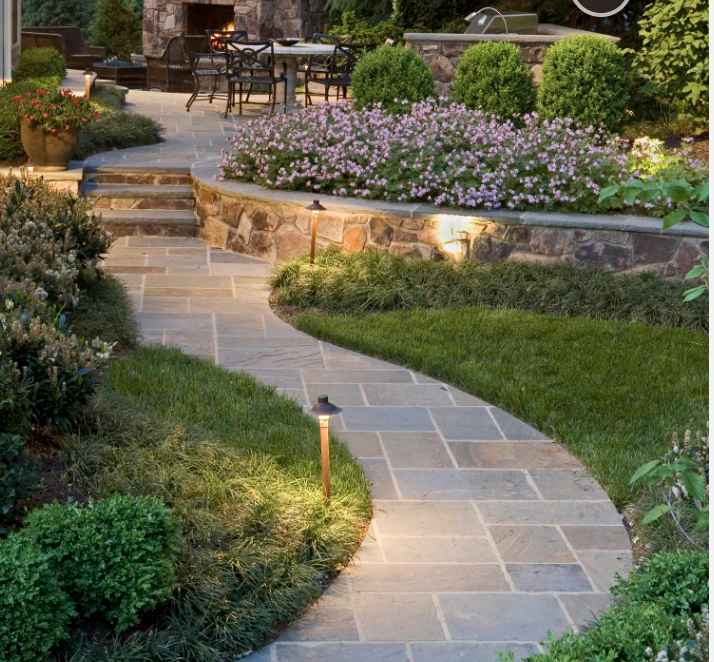
9. Slate Paver Pathway Designs
Slate pavers create an informal path within a well-manicured lawn. The use of large pavers lends a clean and uncluttered look versus using smaller stepping stones.Slate is durable natural stone that is known for its durability and resistance to weathering. It is able to withstand heavy foot traffic and can last for many years without showing signs of wear and tear.
Slate is available in a wide variety of colors and textures, making it a versatile material for any landscape design. It can add natural beauty and character to any outdoor space.
Another benefit to slate is that it is a low-maintenance material that can be cleaned easily with a broom or a garden hose. Slate is a slip-resistant material, making it a safe option for pathways, especially in wet conditions.
Consider lining your slate path with boxwoods for an elegant timeless look. I am obsessed with boxwoods.
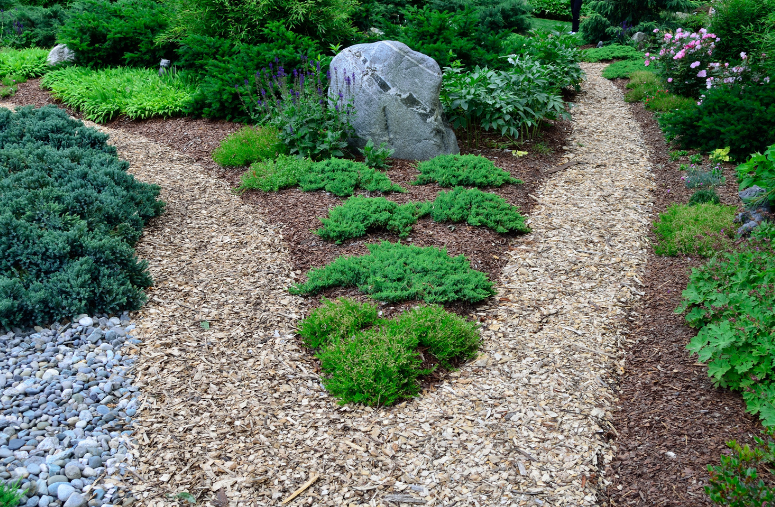
10. Rustic Wood Chip Pathways
Wood chip walkways are inexpensive and make for a cost- effective way to design a pathway. They also work well for wet areas because they are permeable. Wood chips reduce the risk of erosion and stormwater runoff. Another benefit of a wood chip path is that it’s low maintenance.
The wood chips can be made from a variety of sources, such as trees that have been removed from a property, or from sawmills or wood-processing plants. The wood chips are typically spread over a prepared surface, such as a compacted gravel base, and then compacted to create a stable surface for the pathway.
The most common wood chips are:
-
Cedar chips: Naturally rot-resistant and aromatic, cedar chips provide a clean, fresh look.
-
Hemlock chips: Inexpensive and long-lasting, hemlock chips are a popular choice for garden paths.
-
Pine chips: Soft and lightweight pine chips are a good option for a casual, natural look.
-
Hardwood chips: Durable and long-lasting, hardwood chips are ideal for high-traffic areas.
-
Redwood chips: Aesthetic and weather-resistant, redwood chips provide a warm, natural look.
The type of wood chips you should use for a garden path depends on your specific needs and preferences. Consider factors such as durability, cost, maintenance requirements, and the desired look and feel of the pathway when choosing a type of wood chips. In general, rot-resistant varieties such as cedar or redwood are a good choice for a long-lasting, low-maintenance pathway.
“The crushed shells add texture and color to the path, and can complement natural surroundings, such as gardens or water features. Additionally, the shells can help with drainage and prevent weed growth.”
Mark Soboil from ShellScapes
11. Crushed Oyster Shell Paths
Have you ever seen a bright white crushed oyster shell driveway or pathway? It’s stunning! Crushed oyster shells are an ideal material for a sustainable garden path because they have several benefits:
- Sustainable coastal appeal-See my path here.
-
Oyster shells are a strong and durable material that can withstand heavy foot traffic, making them ideal for use in high-traffic areas of a garden.
-
Oyster shells are naturally alkaline, and as they break down, they release calcium carbonate, which can help to adjust soil pH levels. This is especially beneficial for acid-loving plants.
-
Crushed oyster shells can improve soil drainage, which helps to prevent soil from becoming waterlogged and helps plants to grow more healthily.
-
Unlike other materials such as concrete, crushed oyster shells can be recycled and reused in a garden for many years, making them a more sustainable choice.
-
Crushed oyster shells can add a decorative touch to a garden, as they are available in a range of colors and sizes, and can be used to create patterns or designs.
Learn more about eleven reasons to use crushed oyster shell in your landscape. The crushed oyster pathway offers the ideal coastal vibe. I love my oyster shell pathway, see more here.

12. Crushed Basalt Pathway Designs
Crushed basalt is a dark-colored rock that is durable and long-lasting. It can be used to create a modern or contemporary look.Basalt pathways work well in landscape design for several reasons:
- Basalt is a volcanic rock that is highly durable and resistant to weathering and erosion, making it ideal for use in high-traffic areas such as pathways.
- Basalt has a natural, earthy look that blends well with many landscape designs, and it is available in a variety of colors, textures, and sizes, which makes it versatile.
- Basalt has a rough texture that provides a slip-resistant surface, making it safer to walk on in wet conditions.
- Basalt requires very little maintenance, as it is not easily stained or scratched, and it does not require regular sealing or treating like some other materials.
Overall, the combination of durability, aesthetics, slip-resistance, and low maintenance make basalt a popular and practical choice for pathways in landscape design.
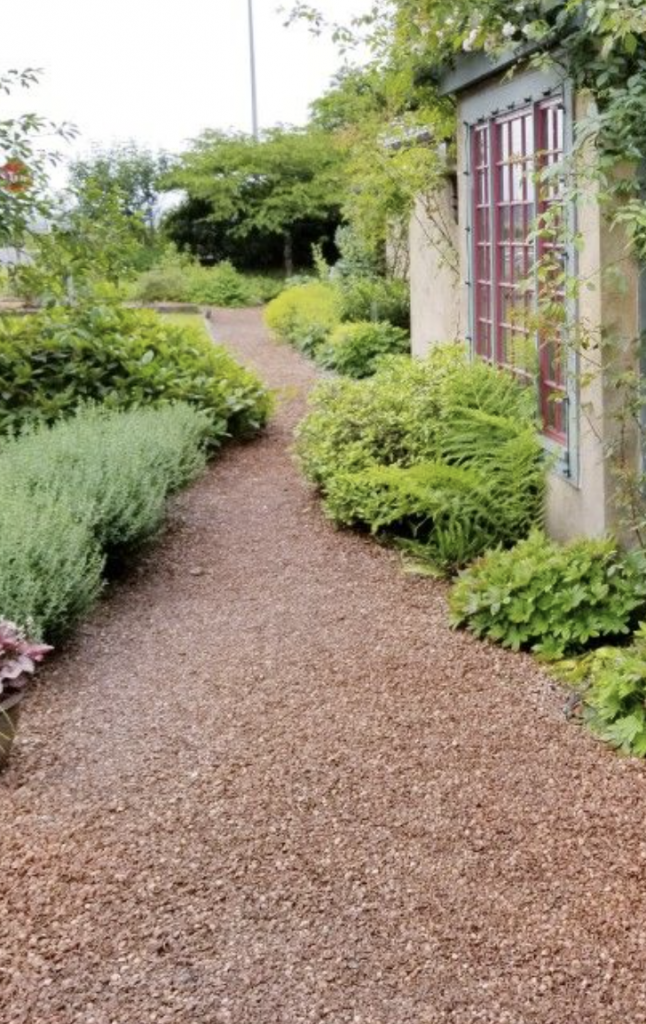
13. Hazelnut Shell Pathway
Hazelnut shells are typically collected from hazelnut processing plants, where they are a byproduct of the nut-cracking process. Once collected, the shells are cleaned and crushed into small pieces.
Hazelnut shell pathways can be used in a variety of settings, such as gardens, parks, and walkways. They are a popular choice for pathways because they are:
-
Environmentally friendly: The shells are a byproduct of hazelnut processing and are a sustainable and renewable resource.
-
Durable: Hazelnut shells are very hard and durable, making them resistant to wear and tear.
-
Low maintenance: Hazelnut shell pathways do not need to be sealed or painted, and they are resistant to rotting and decay.
Hazelnut shell pathways have a unique look and feel, as they provide a natural and rustic look, and have a slightly rough texture. They are also available in different shades and tones, depending on the region where the hazelnuts have been grown, and the type of hazelnut variety.
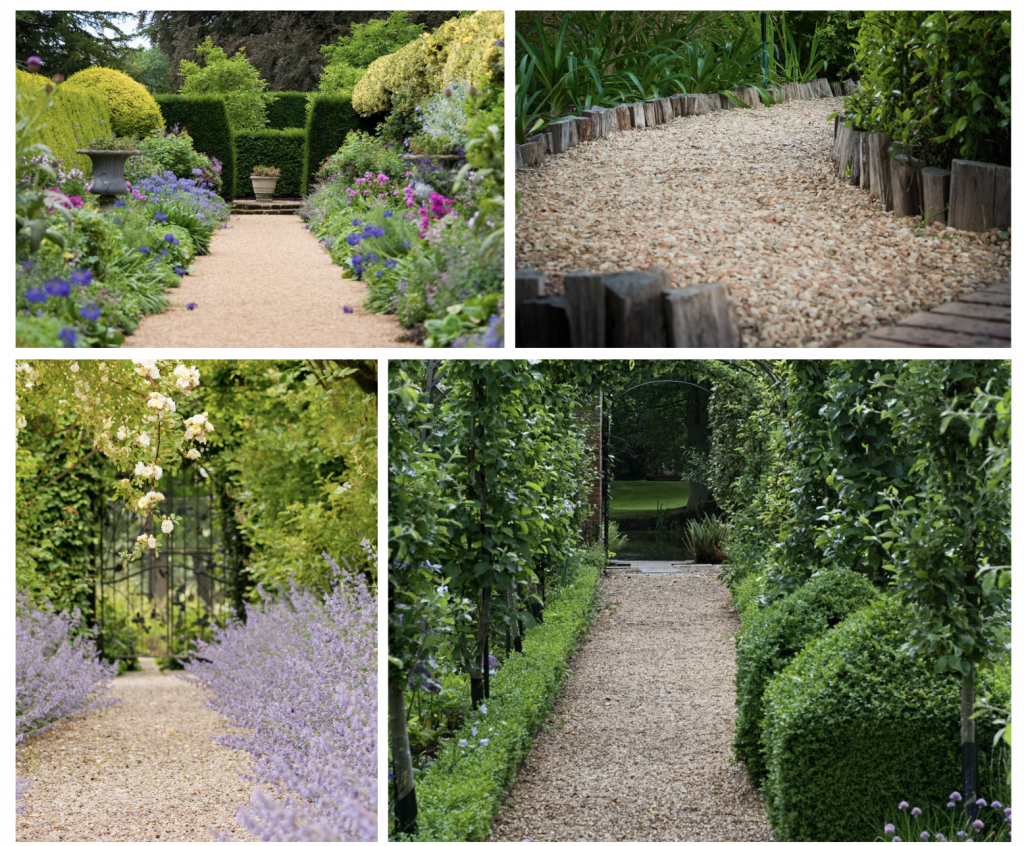
14. Gravel Walkways
Gravel is a popular choice for pathways because it is inexpensive and easy to work with. It comes in a variety of colors and sizes, and can be used to create a natural, rustic look.
Gravel paths are easy to install yourself which will save you money. The key is using a durable edge to contain the gravel. Galvanized steel is a durable and traditional choice and also malleable enough for curves. But you can also use pressure-treated wood, cedar, bricks, cobblestones, or even plastic edging.
What type of gravel you can use?
-
Pea Gravel: small, round stones that create a loose, informal pathway.The gravel, being so movable, needs an edge to contain it.
-
Crushed Gravel: angular stones that provide good stability and are cost-effective.
-
River Rock: large, smooth stones that create a natural look.
-
Limestone: light-colored stones that provide a clean, classic look.
-
Decorative Gravel: a variety of colored stones for a unique, colorful pathway.
The best type of gravel to use for a garden pathway will depend on the desired look and function of the pathway, as well as local climate and soil conditions. Consider factors such as stability, drainage, and maintenance requirements when choosing a type of gravel.
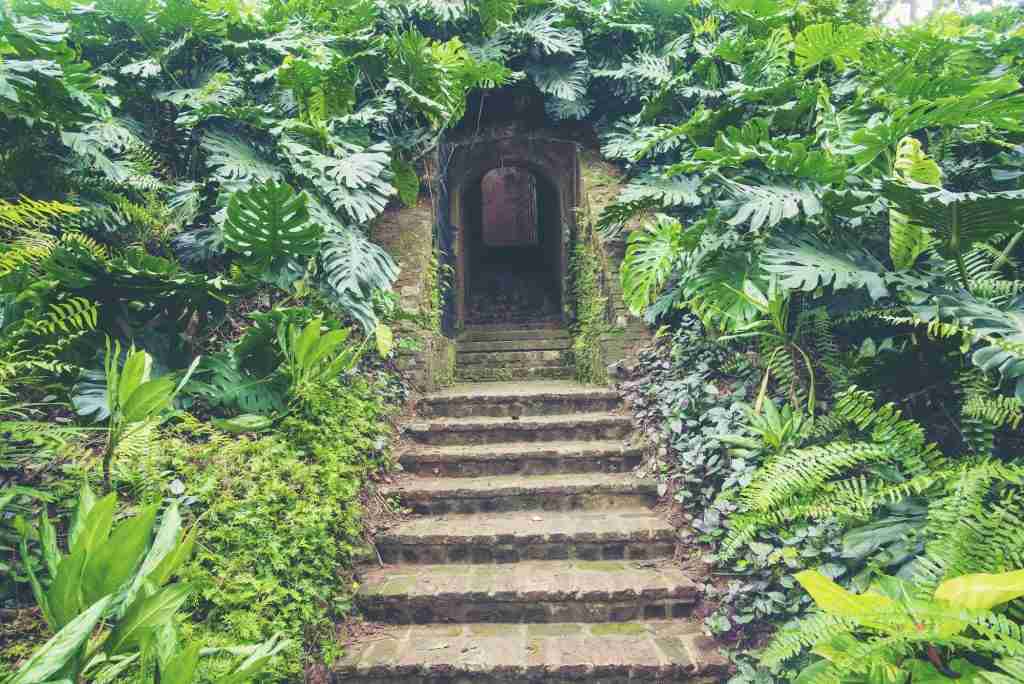
15. Traditional Brick Path
People love winding brick walkways for their aesthetic appeal, versatility, and ability to enhance the look and value of a property. The organic, curved shape of a winding walkway contrasts with the straight lines and angles of a typical walkway, creating a more inviting and interesting environment.
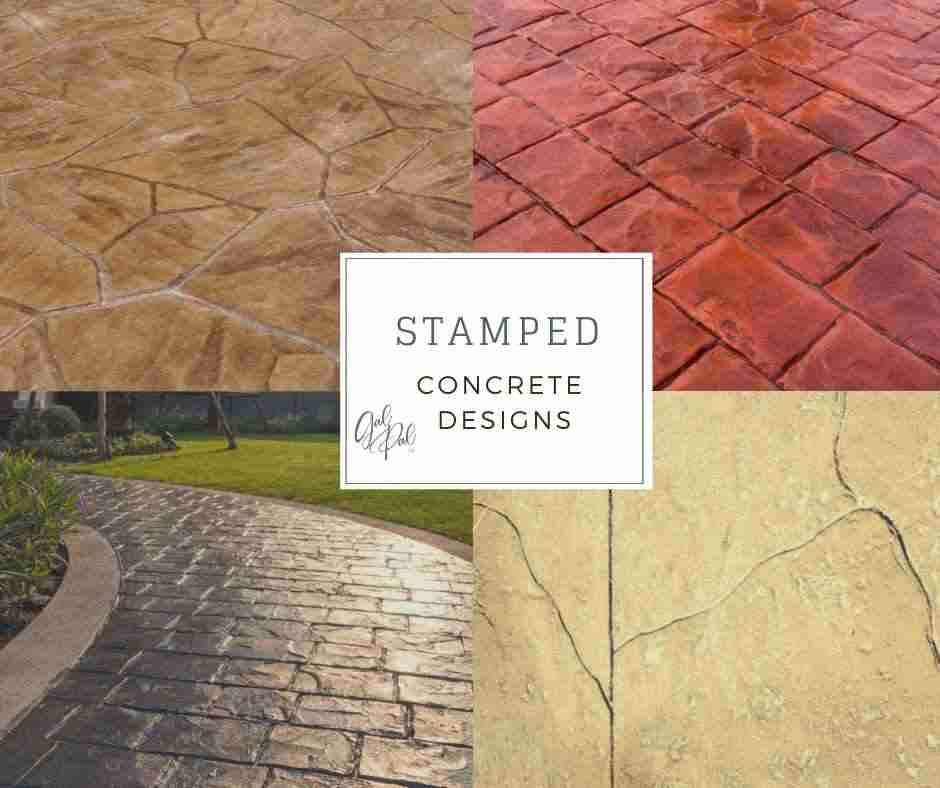
16. Stamped Concrete Path Ideas
Stamped concrete is a good idea for landscape design because it offers several benefits, including:
-
Durability: Stamped concrete is a strong and durable material that can withstand heavy foot traffic and extreme weather conditions.
-
Low maintenance: Unlike other materials such as natural stone or brick, stamped concrete does not require regular sealing or upkeep and is easy to clean.
-
Versatility: Stamped concrete can be customized to resemble a variety of textures and patterns, making it a versatile option for any style of landscape design.
-
Cost-effective: Compared to other hardscaping options like natural stone or brick, stamped concrete is more cost-effective and can provide a similar look for a lower cost.
-
Long-lasting: When installed correctly, stamped concrete can last for many years and provide a durable and attractive surface for your landscape design.
-
Customizable: Stamped concrete can be tinted or stained to match the color scheme of your landscape, allowing for a custom and personalized look.
-
Climate-resistant: Stamped concrete is resistant to extreme temperatures and can maintain its appearance and strength in a variety of climates.
Get Creative With Stamped Concrete Paths
The modern concrete paving incorporates various stamped concrete pathway ideas that you can consider for your residential landscape:
-
Cobblestone pattern: A cobblestone pattern mimics the look of natural stone and provides a timeless, classic look. This pattern works well in traditional or formal gardens.
-
Brick pattern: A brick pattern provides a warm, inviting look and is often used in cottage-style or informal gardens.
-
Wood plank pattern: A wood plank pattern gives a pathway the look of a wooden boardwalk and can add a rustic or natural feel to your landscape.
-
Ashlar pattern: An ashlar pattern mimics the look of cut stone and is often used in formal or traditional gardens.
-
Random stone pattern: A random stone pattern replicates the look of a natural stone path and can give a garden a more relaxed and informal feel.
-
Mosaic pattern: A mosaic pattern can add a unique and intricate design element to a pathway and can work well in a variety of garden styles.
-
Mediterranean pattern: A Mediterranean pattern provides a warm, rustic look and is often used in Mediterranean or Tuscan-style gardens.
-
Travertine pattern: A travertine pattern mimics the look of natural travertine stone and provides a classic, elegant look.
-
Flagstone pattern: A flagstone pattern gives a pathway the look of a natural flagstone path and can add a rustic or natural feel to your landscape.
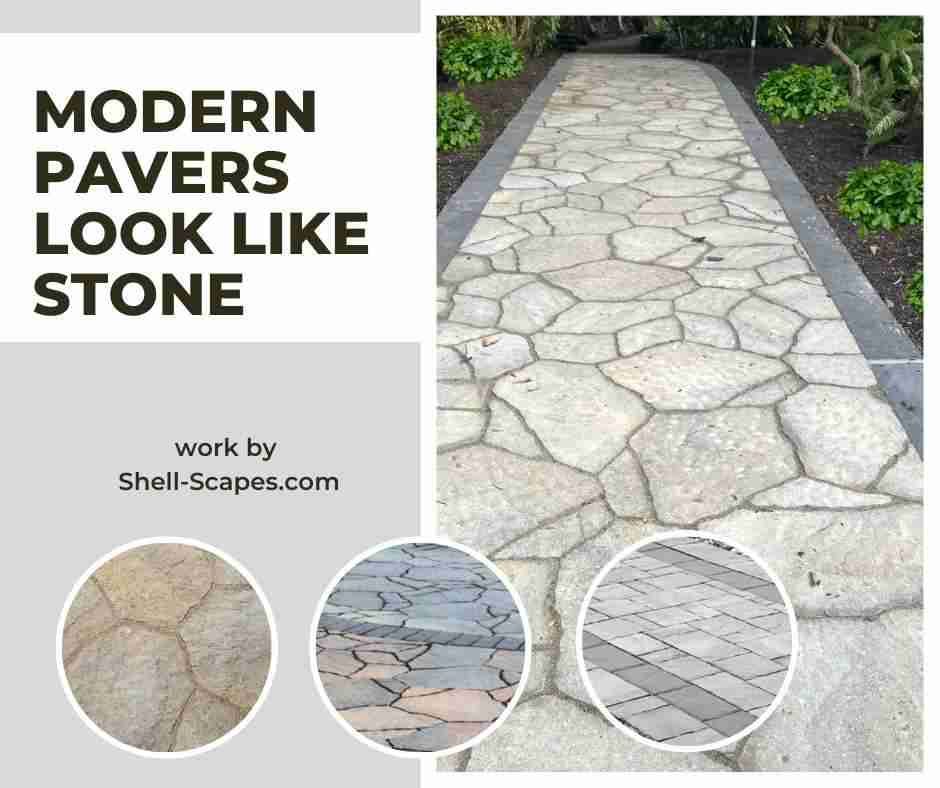
Concrete Driveways and Pathways Have come A Long Way
Gone are the days of plain concrete and asphalt driveways and paths that were purely functional. Today, concrete and asphalt driveways have come a long way in terms of design, offering a variety of options to enhance the curb appeal and overall aesthetic of our homes.
A concrete driveway and walkway today has undergone a significant transformation with the introduction of decorative concrete techniques. From stamping and concrete pavers as seen below. The good news is you don’t need to invest in the high costs of a poured asphalt or concrete pathway because you have other choices.
17. The New Interlocking Concrete Pavers- That Resemble Flagstone
Mega-Arbel offers the look and feel of natural flagstone. With an irregular shape and virtual joints, it creates a random look that flows harmoniously into the surrounding landscape. Perfectly integrated, natural-looking hardscapes they desire. Its scale is similar to natural flagstone. With its irregular shape and textured surface, Polymeric Sand is recommended for use with these pavers.
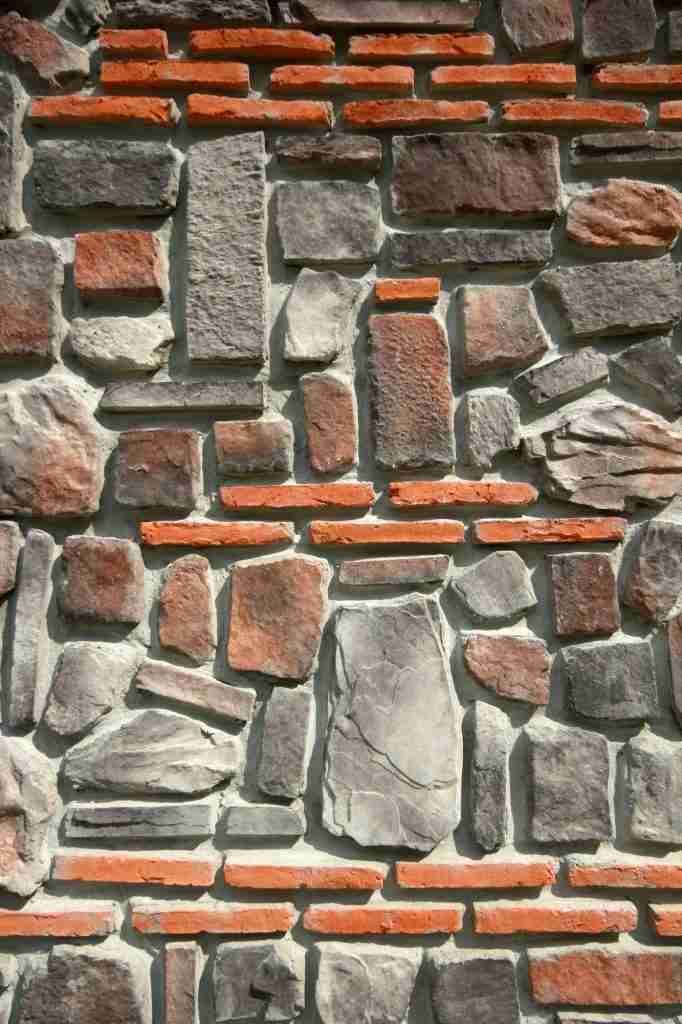
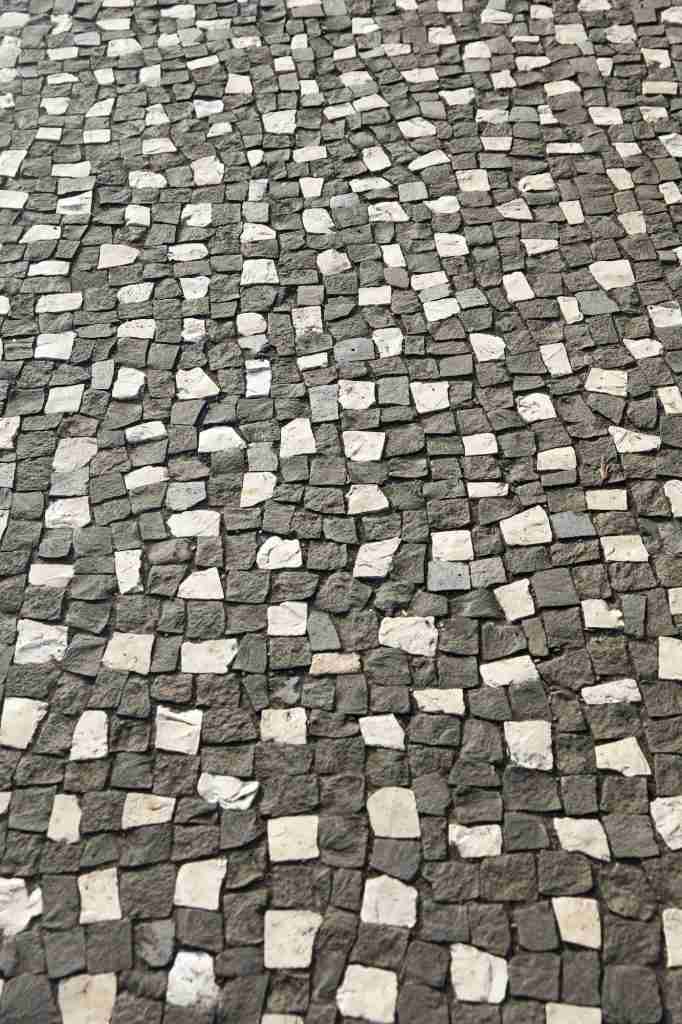
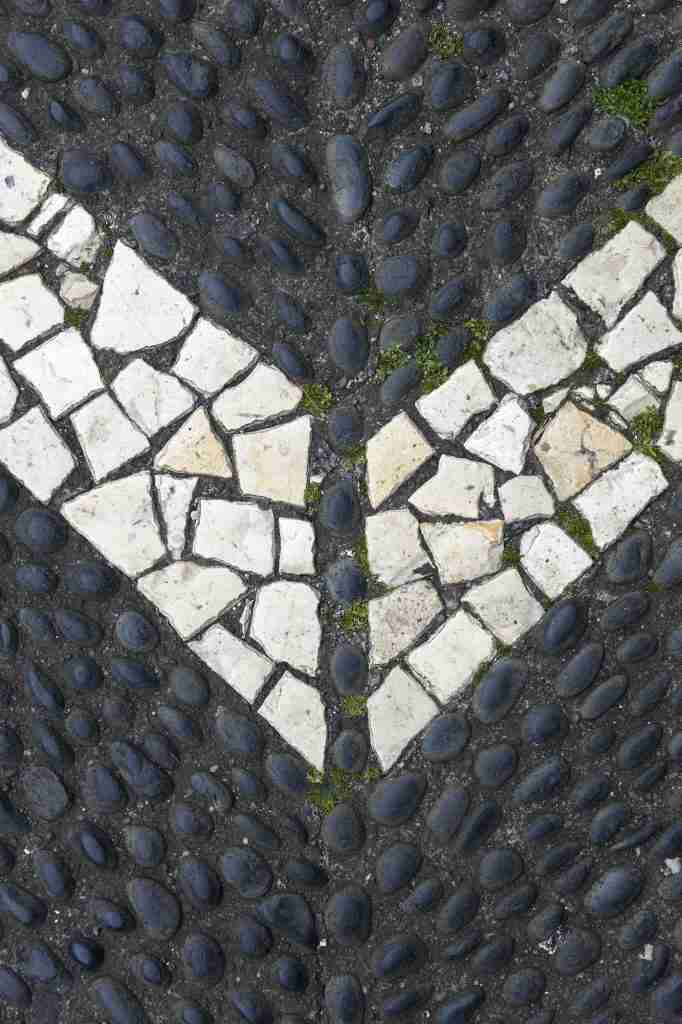
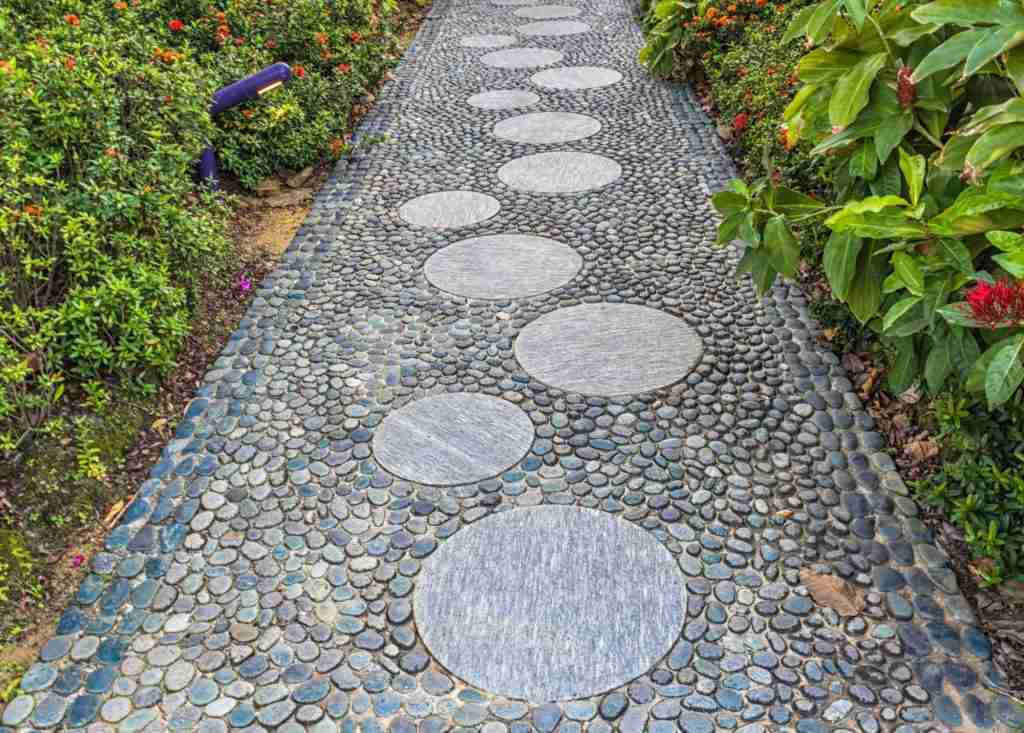
18. Multi Mixed Walkway Materials
Mixed material pathways are a popular and versatile landscaping option, combining two or more materials to create a unique and visually interesting design. Besides gravel and shell with flagstone, some other popular mixed material pathway designs include:
-
Flagstone and brick: Flagstones and brick are arranged alternately to create a traditional and formal look.
-
Brick and stone: Bricks and stones are combined to create a rough and natural look, ideal for a country or rustic garden.
-
Concrete and wood: Concrete and wood are combined to create a modern and urban look, suitable for a contemporary landscape.
-
Concrete and stone: Concrete and stone are combined to create a sophisticated and natural look, perfect for a minimalist garden.
Frequently Asked Questions – Residential Landscape Pathway Design:
What materials should I use for my pathway?
- Common materials include pavers, flagstones, gravel, crushed shells, and mulch. Concrete sidewalk designs will give you a good idea on how you can style any pathway. Consider what type of plant material that will be planted next to the path. For instance, the timeless boxwoods are ideal to plant alongside a path.
How wide should my pathway be?
- The width of the pathway should be determined by its intended use, the amount of foot traffic it will receive, and the overall design of your landscape. A minimum of 3 feet is recommended for a single-person walkway, while a pathway for multiple people or garden furniture should be at least 4-5 feet wide.
How long should my pathway be?
- The length of the pathway should be determined by the size of your property and your desired layout. A pathway can be as short as a few feet or as long as hundreds of feet, depending on your needs.
How much does an average path cost?
- The cost of a pathway varies depending on the materials used, the size and length of the pathway, and the complexity of the design. A simple gravel pathway can cost as little as a few hundred dollars, while a complex flagstone pathway can cost several thousand dollars.
How do I incorporate lighting into my pathway design?
- You can incorporate lighting into your pathway design by adding low voltage LED lights along the edges, incorporating solar lights, or using lanterns or sconces to highlight key areas of the pathway.
How do I plan and design my pathway?
- Start by determining the function of your pathway and its desired location. Consider the surrounding landscape, the shape of the pathway, and the materials you would like to use. You can also consult with a landscape designer or architect for guidance.
How do I maintain my pathway?
- Regular cleaning and sweeping to remove debris, periodic edging to maintain the shape of the pathway, and annual resurfacing with fresh materials are the key to maintaining a pathways.


